Accidental Gardeners
With trial, error, dumb luck – and joy – two neophytes transformed four acres of bramble and meadow into a painterly Hockley garden.
“Are you nuts? Why are you weeding the forest?” An astonished friend asked this about 30 years ago when he came to visit our newly built Hockley home and watched my husband, Andrew Weiner, and me tearing out wheelbarrows of wild raspberry bushes on the edge of the forest.
I wish I could say this fruit-killing foray was inspired by a vision of a naturalistic garden – one that has come to follow and reinforce the contours of the landscape where open meadow meets a brooding forest bowl, lined by huge boulders with drifts of woodland perennials in the shady background and sun-loving perennials in the front.
But our task wasn’t inspired by a vision. I just hated the prickly bushes that required a half day of picking to yield a thimbleful of raspberries. I was removing something ugly – not moving toward creating something beautiful. All I could answer my friend was that it seemed like a good idea, even if I didn’t know why.
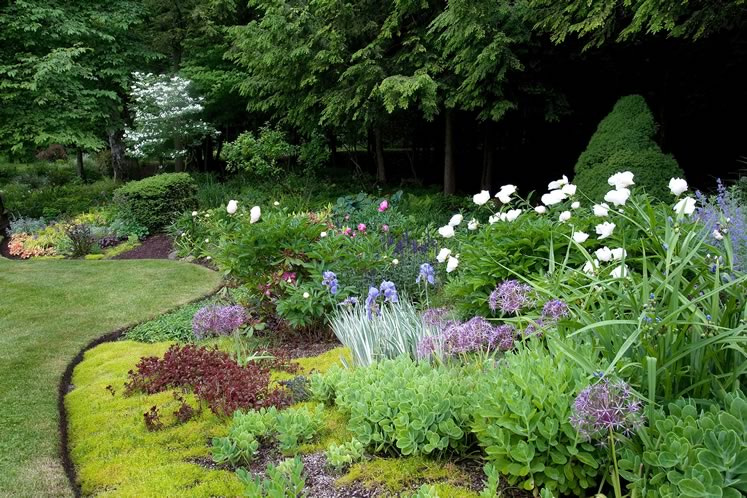
An inviting wave of colour and form marks the transition from field to forest in the writer’s expansive Hockley garden. Photo by Rosemary Hasner / Black Dog Creative Arts.
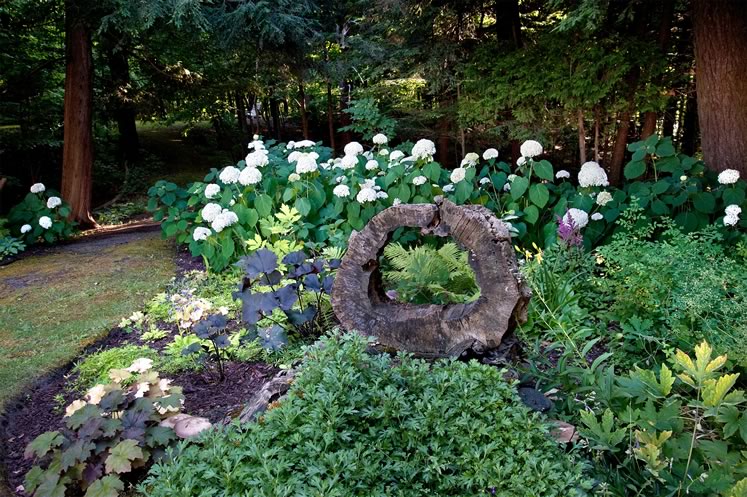
A hollow stump makes a natural sculpture of found art. Photo by Rosemary Hasner / Black Dog Creative Arts.
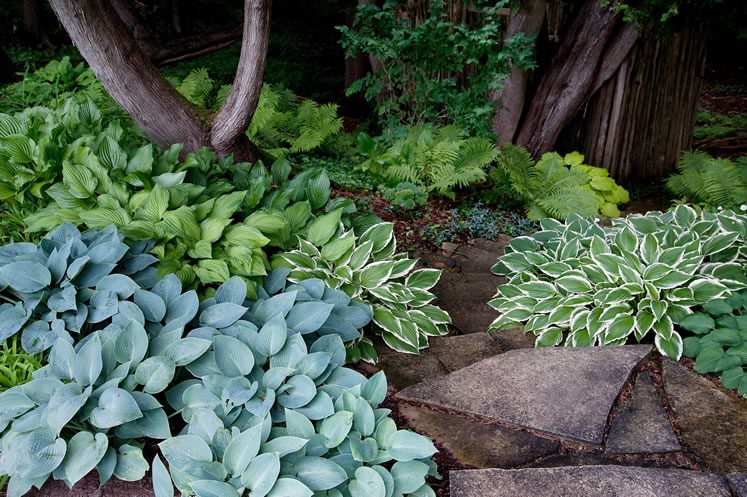
Colourful hostas and stone steps lead invitingly down from garden to forest hollow. Photo by Rosemary Hasner / Black Dog Creative Arts.
As is often the case with self-taught gardeners, Andrew and I never had a master plan. Our garden simply evolved and expanded organically, no pun intended, over time. It was only when we were left with a large swath of emptiness with all the charm of an abandoned bus lot that the concept of how to fill it was born.
In my professional life as a work/life specialist, I tell people their careers will evolve meaningfully and naturally if they build on what they are good at in the environment in which they thrive. The same is true of gardens – basically, work with what you have and build on what works.
For example, we first planted the former bramble patch with several flowering shrubs (lilacs, weigela, viburnum). When what seemed like a wall of foliage began to emerge, we made a bolder statement by planting about 25 more shrubs and fruit trees. The usual suspects of sunny perennials such as sages, veronicas and phloxes followed. But the bushes looked weak as a backdrop, so in went the cedar hedgerows to create structure and a strong foil.
Like many novice gardeners on a budget, I was opportunistic. If someone gave me a garbage bag full of plants, I happily took it. Free material! Will fill in lots of holes! Note to novice gardeners: Be judicious when someone gives you a lot of one kind of plant because it’s probably invasive. Andrew and I spent far too much energy over the years trying to keep the donated ditch lilies, periwinkle and geraniums under control.
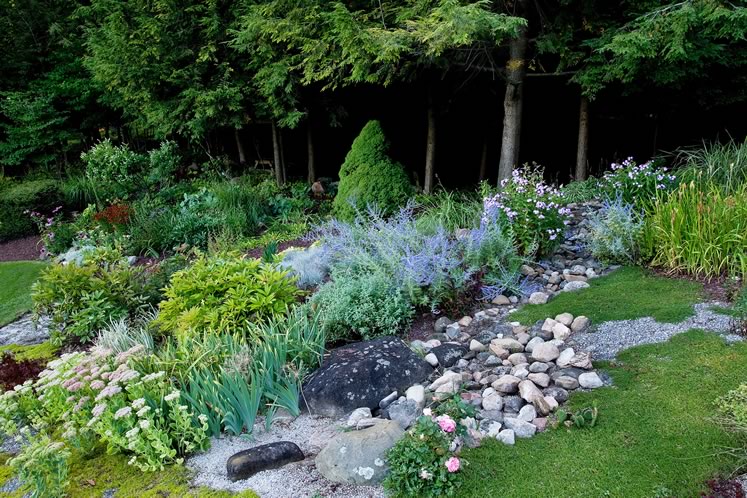
Rocks and gravel run like a natural stream through a section of the garden. Photo by Rosemary Hasner / Black Dog Creative Arts.
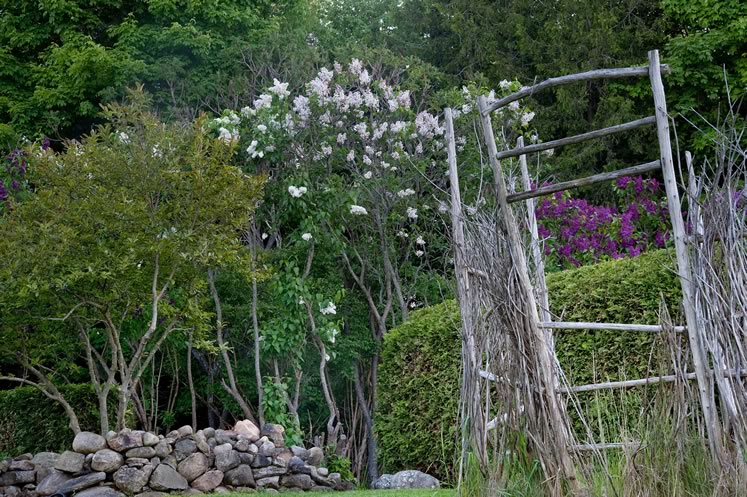
A weathered trellis provides a rustic frame to the burst of spring lilacs. Photo by Rosemary Hasner / Black Dog Creative Arts.
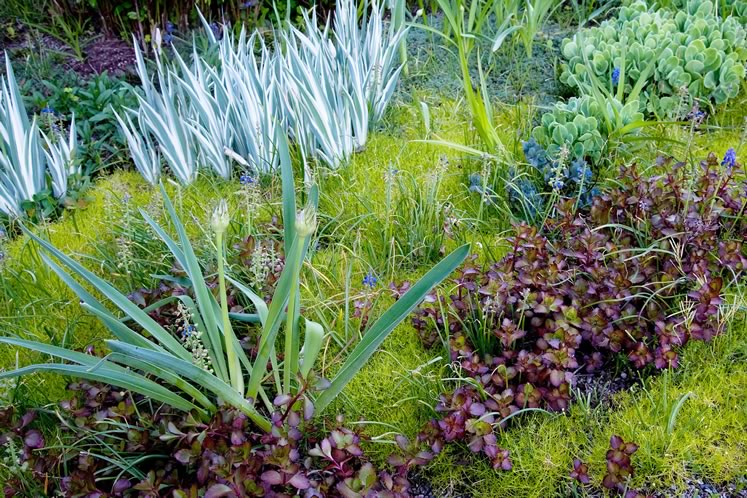
Low red-leafed sedum and variegated iris poke through chartreuse Scotch moss to create a profusion of colour even when blooms are scarce. Photo by Rosemary Hasner / Black Dog Creative Arts.
Architect Claude Liger-Belair had positioned our house on a meadow hillock just east of the forest to take advantage of long views over Hockley hills’ rooftops through to distant Brampton lights. A hundred-year-old beech about 40 feet from the house provided an important perspective point. One night, shortly after the arborist had finished pruning the majestic tree, we felt the earth tremble. We thought it was an earthquake. It wasn’t – the tree had crashed.
That is how our second garden area evolved. Across from the house it is defined by two hillocks, shaped like an asymmetrical bosom – what I call a C cup, cleavage defined by paths on both sides, and a triple-Z cup. It is a largish area, almost half an acre. Daunted by its size, we hired someone to prepare the soil and plant the garden. But he wasn’t a plantsman or a designer. Shade-loving plants were in the sun and vice versa; large shrubs in front stopped the eye. Many of the plants died, and we moved most of the rest.
We later found two masterful gardeners, Susan Feindell and Sue Edwards, to assist with weeding and jobs requiring artisanal skills we lack. But it was from that first unhappy experience with outsourcing that I found my gardening voice – realizing that if I trusted my own instincts, I could design the garden myself. Which I did. But in stages. Because after I replanted the garden, which I’d conceived as a transition between meadow and forest, it struck me as garden interruptus, since it stopped about 400 feet from the far end of the forest it bordered.
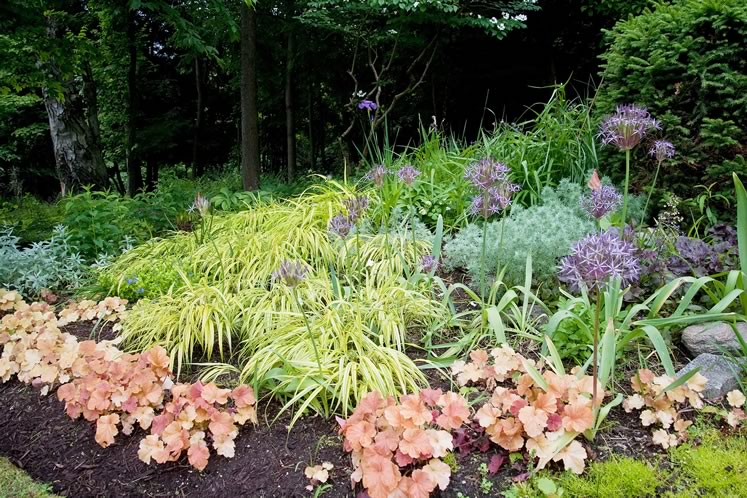
Large allium blossoms float above the leafy colour of amber heuchera “Northern Exposure” and golden Japanese forest grass. Photo by Rosemary Hasner / Black Dog Creative Arts.
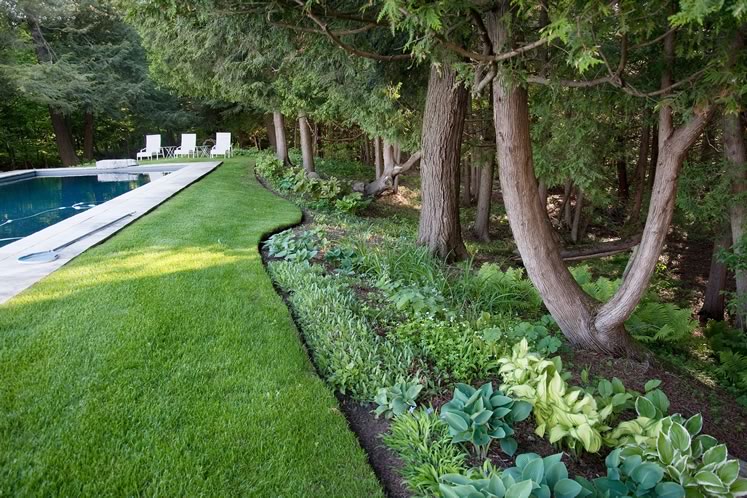
The deep blue pool, modelled on European reflecting pools, complements the blues and pale yellows of the hostas that line the edge of the cedar wood beside it. Photo by Rosemary Hasner / Black Dog Creative Arts.
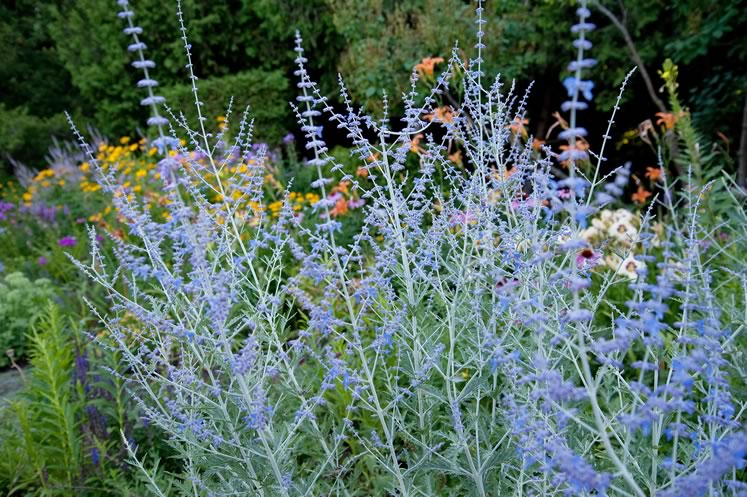
Pale blue Russian sage provides airy height and a soothing note next to the hot hues of midsummer lilies and rudbeckia. Photo by Rosemary Hasner / Black Dog Creative Arts.
So we continued. And continued. Because every time we stopped – one transition garden after another – it still looked like garden interruptus, until we got to the forest’s end. Like a sentence, the garden needed a period. (The garden now runs continuously about 1,100 feet, varying from 20 to 100 feet wide.)
I wasn’t a complete gardening virgin when I started. With a typical mid-Toronto handkerchief-sized garden, I was interested in gardening. I had read natural gardening expert/photographer Ken Druse’s book The Natural Garden. My summarized takeaway: Think of the entire landscape of meadows and forests as “garden,” and the cultivated area as “makeup,” in the way makeup enhances the bones of an already beautiful face.
Notwithstanding, there is tremendous artifice in creating a so-called natural garden – the plants should look like they were born there. The design and feel should be the opposite of loud, attention-hijacking, “look at me” plantings, but rather blend seamlessly into the forests and meadows around them.
I dislike gardens in which each section looks like it was planted by a different person – a composition borrowed from a friend’s Japanese garden, another from a blog on hot colour trends. I wanted the garden to knit together by repeating themes that keep the eye moving. Currently in the woodland (the original sweet woodruff and Solomon’s seal were killed over several winters), there are astilbes, ferns, lady’s mantle and rodgersia, and in the sunny area, thymes, veronicas, artemisias and sedums, which show up in different combinations throughout. Colours in various forms – greys, reds, chartreuse – also repeat.
Because of the garden’s scale, each area has a sobriquet which changes with my mood. Sometimes it references what had been there (the beech tree garden), or its shape (the bosom garden). Sometimes it references location (upper middle), what is going on in the garden (the hot garden, the hydrangea garden), or how I feel about it (the neglected garden, the naïve garden, which is what I call my original garden). And sometimes it references its development over time (the former transition garden, the new transition garden, the new new transition garden). The descriptors work for me, but not so much when I sent Andrew or the gardeners to work in one of them. Go figure.
On a garden tour about 10 years ago I saw three gardens, each different but beautiful in its own way. The first was a magnificently maintained, highly manicured, green and white oasis with perfectly clipped boxwoods, exclusively white flowers and a weedless lawn. The second was a profusion of colour – weedy and chaotic but spectacular in its exuberance. The third garden was seductively atmospheric with a clearly conceived but relaxed design. It was well maintained, but not OCD weed-free.
The juxtapositions struck me. Each seemed to represent a personality style: the manicured garden, the controlled introvert; the exuberant garden, the enthusiastic extrovert; and the last one, which combined the cognitive (design) with the joyful, the flexible ambivert. Me? I think I am a control freak introvert gardener trying to pass as a tolerant laissez-faire ambivert. As a friend’s then-adolescent daughter said, on observing me repeatedly digging out recently planted perennials, “Every time you go into the garden the plants send out an emergency alert: Duck! Crazy lady with shovel coming.”
It is said that gardeners fall into two camps – plant lovers enthralled by the unique characteristics of a particular plant, and designers who consider plants “material” for painting on a living canvas. I fall into the latter camp. I am trying to paint with plants, using them to create broad brushstrokes of colour. Although we have a few unusual plants, most were chosen for their ability to maintain good form through the seasons. (No staking! I dislike high-maintenance, “I’m so pretty” princess plants. Peonies are an exception, though I don’t stake them.) Also critical is the colour and shape of their foliage, and how they relate in colour, form and texture to surrounding plants.
Another rule: Plants need to play nice. No more tyrants gobbling up 10 times their allotted space, spreading malignant rhizomes and wanton seeds everywhere. And no more under-assertive snowflakes. That’s the fantasy, at least. (Often, instead of accomplishing the year’s to-do list, we spent weekends digging out wheelbarrows of obnoxious aggressors.)
Foliage colour is particularly important to me, especially in the bosom garden because of the sightlines from the house. I planted it to hold its own throughout the season with contrasting foliage providing the interest – chartreuse moss and forest grass with amber-coloured heuchera, punctuated by changing blossoms of purple and blue flowers to cool down the foliage. For example, purple sedum pairs with grey thyme and chartreuse moss. The latter is especially delicious when the red-stemmed sedum snakes through it.
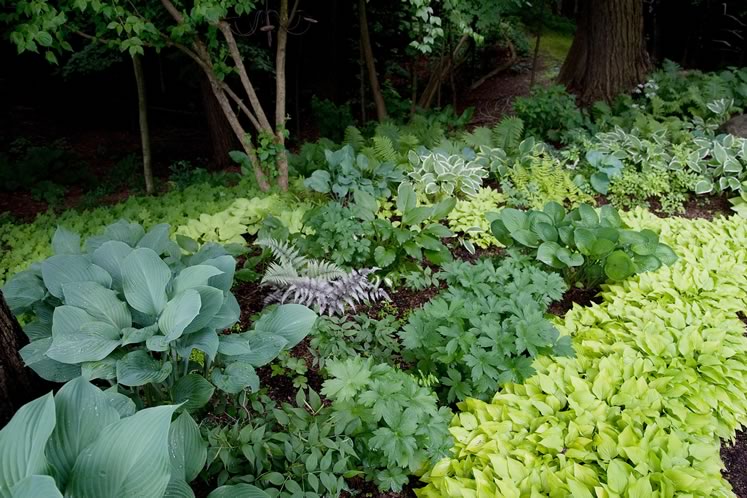
Streams of hostas punctuated by pinky-green Japanese and other ferns demarcate the shady edge of the woods. Photo by Rosemary Hasner / Black Dog Creative Arts.
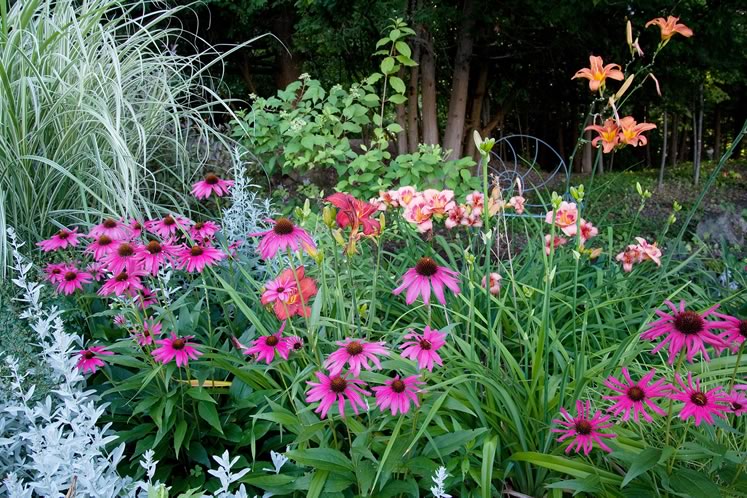
Mauve-pink echinacea and a variety of hot pink and orange lilies combine with the soft grey-green of artemisia and maiden grass to make an enchanting July palette. Photo by Rosemary Hasner / Black Dog Creative Arts.
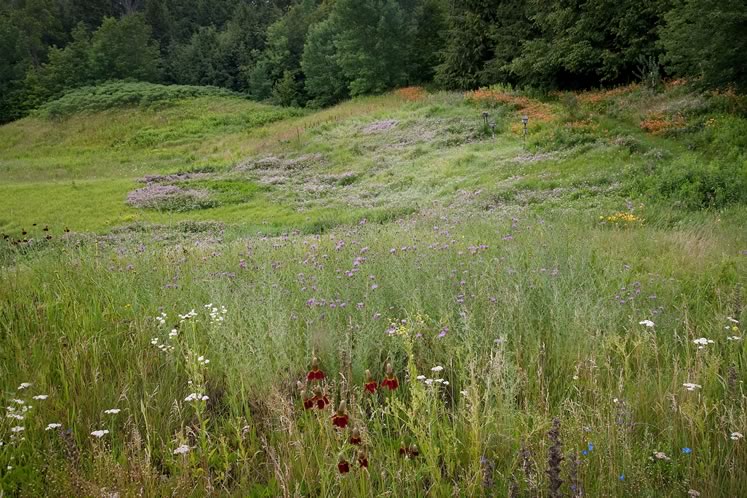
Beyond the more cultivated gardens, the summer meadow flushes with hazy sweeps of wildflowers. Photo by Rosemary Hasner / Black Dog Creative Arts.
Gardens also need hardscaping. In our garden, the concrete pool with its stone apron was inspired by old European reflecting pools. And because I wanted something muscular to divide the pool area from the driveway, we added a dry stone wall. Andrew dubbed the current incarnation Wall 3.0 (because the first two walls we built collapsed). Dry stone waller Eric Landman promised this one would last decades beyond our lifetimes.
I still make mistakes. In 2018 we lost a patch of sweet woodruff by the forest edge. Being expedient and opportunistic, I transplanted nearby fleece flower ground cover (not a woodland plant) to fill it in. It looks like a condo landscaper has just left the property. And I’m still struggling with the cleavage in the bosom garden, replanted so many times I don’t remember previous incarnations. It’s still not right.
And then there is the winterkill heartbreak. The rusty foxglove, which provided structure and the perfect weird colour, is gone, as are the large drifts of sculptural grasses we spent years developing. Over a hard winter two years ago, we lost about 300 plants, leaving huge holes still not entirely filled.
But the love affairs continue. Some are inevitably promiscuous seasonal crushes, but the long-term ones include Russian sage for silver “need-it-everywhere” foliage and architecture, knautia and allium for playful balloon-like flowers floating above other perennials, and sedums for form (and because even clumsy transplanters like me can divide and replant them).
Like most gardeners, I thrive not only on the intimacy that envelops you in the garden, but on the drama of the marquee moment. In spring, it’s the glorious explosions of pinks, purples and reds from the lilacs and flowering fruit trees, followed by hot pink peonies and the lavish colour combinations of orange poppies with electric purple Siberian irises, or soft grey artemisia with neon fuchsia carnations. Come summer, it’s the waves of changing shades from prairie perennials, such as rudbeckia.
Just as many people say they drifted into their careers and never planned to become what they became, we drifted into creating a large-scale garden mostly instigated by the landscape. Gardening is inspiring; however, I’ve learned it’s not for sissies. I still fret over rapacious thugs and lost treasures, but spring inevitably fills me with hope and the anticipation of many years of inspiration as the garden continues to grow, not in scale but in refinement.
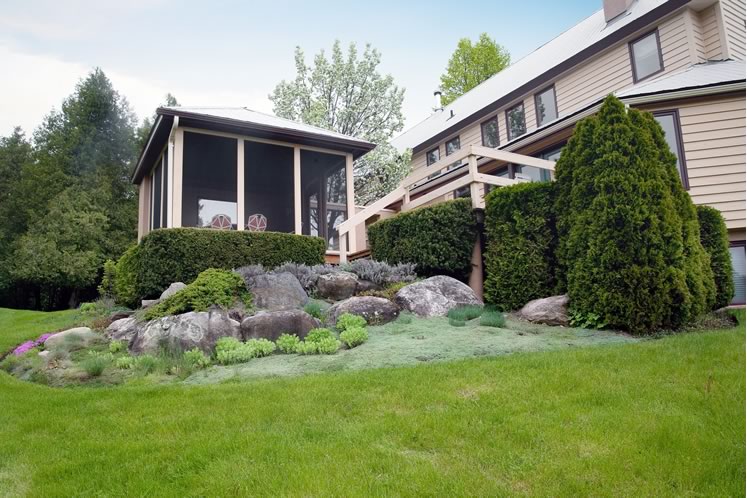
Perched on a hillock, the house links to its natural surroundings with clipped cedars that give way to plantings amid a cascade of field boulders. Photo by Rosemary Hasner / Black Dog Creative Arts.
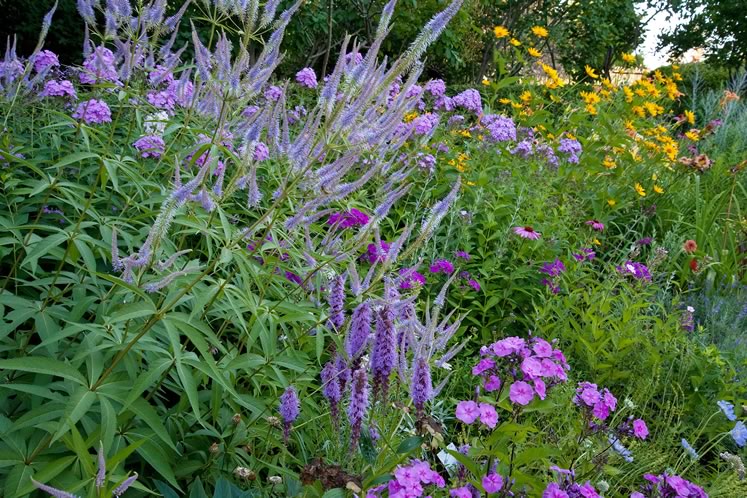
Spiky Veronica, fuzzy liatris and cheerful phlox provide a symphony of blue against golden rudbeckia as July turns to August. Photo by Rosemary Hasner / Black Dog Creative Arts.
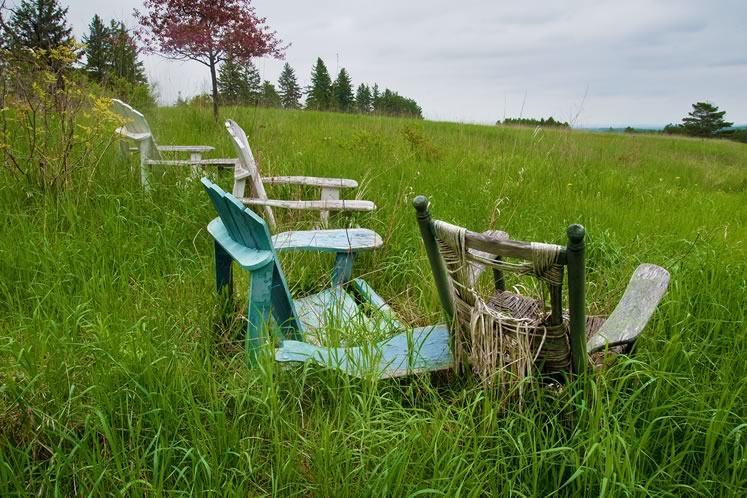
A collection of aging Muskoka chairs blends into the meadow, providing a spot for rest and reflection. Photo by Rosemary Hasner / Black Dog Creative Arts.
Postscript
It is the nature of gardening articles that they are written well before publication. Photographer Rosemary Hasner documented our garden throughout last year, and I wrote my reflections last fall. But seasons change, and life changes with them. Tragically, in early December, Andrew, my husband of 46 years, died following a sudden and brief illness.
Andrew and I had always done most of the garden work ourselves. Though we laboured side by side, my preoccupations tended to colour, design and form – and weeding. For Andrew it had more to do with the sheer joy of physical labour. With a stamina I could never match, he would spend hours walking up and down the hilly terrain with a heavy wheelbarrow, planting, mulching and taking special pride in pruning to open and shape the views, before finally returning to the house happily encrusted in soil and sweat.
As I reread my concluding paragraph from last fall, I realize that this spring, for the first time ever, I will approach the garden with ambivalence. Perhaps more than anywhere else, it was the place Andrew and I communed most easily – creatively, often wordlessly, united in our common and meditative purpose. As the days grow warm, my fond hope is that I will return to the garden and find a place of solace, where our two spirits still reside together amid the growing things we nurtured. Time will tell.
Related Stories
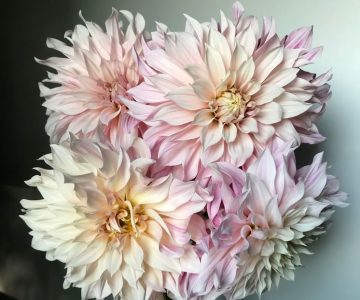
The Green Thumb: Broadside Flowers
Mar 19, 2019 | | FarmingTerra Cotta landscape gardener Amanda White’s own garden is brimming with foxgloves and dahlias.
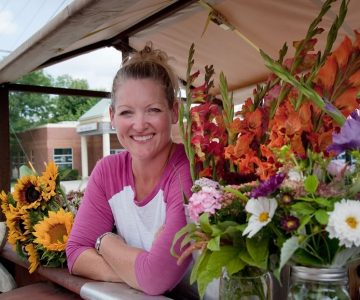
The Florist Farmer: Petals Flower Co.
Mar 19, 2019 | | FarmingMelanthon’s Amber Swidersky creates lush bouquets with blooms just steps from her floral studio.
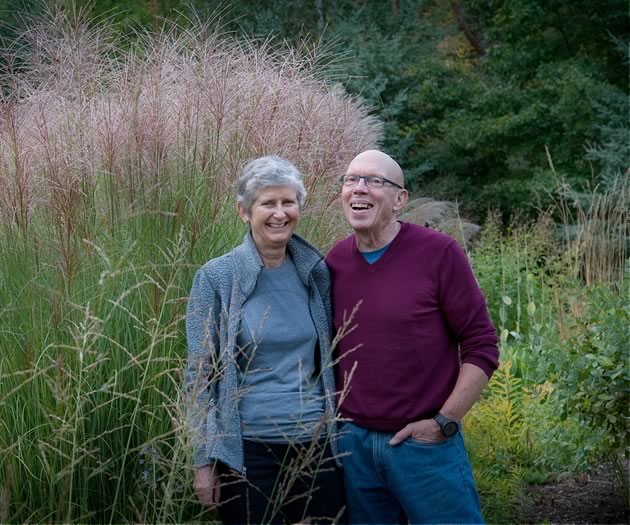
A Botany of Desire
Mar 20, 2017 | | LeisureGardener Liz Knowles’ passion for rare yet rugged alpine flora has transformed her Mono gardens into more than an aesthetic triumph. They’re an aide memoire of her life and travels 40 years on.
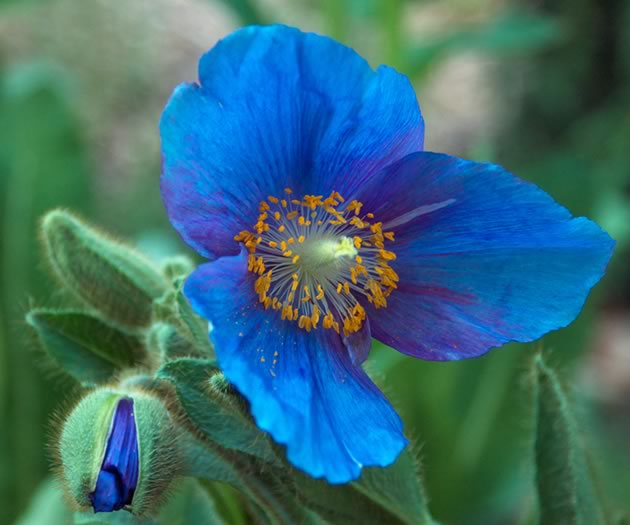
Stars of Larkspur Hollow
Mar 20, 2017 | | LeisureUp close and personal with some of the stars of Liz Knowles’ garden – many of them from alpine destinations in Central Asia, China and India.

A Purposeful Garden
Mar 23, 2015 | | LeisureMisha Dubbeld’s gracious Mono garden is a testament to 20 years of love and labour. With all that she’s learned, her latest project is conceived on a grand scale.
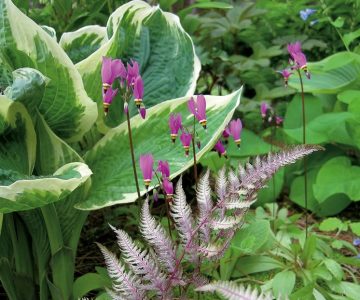
Matches Made in Heaven
Mar 21, 2016 | | LeisureHow Lorraine Roberts conjures up dreamy landscapes using colour, shape – and an appetite for surprise.
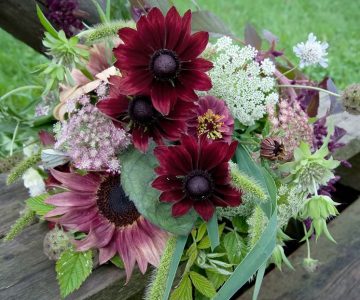
Life at a Flower Farm
Mar 19, 2019 | | FarmingMeet the women behind the blooms at Petals Flower Co., Purple Hill Lavender Farm, Stonewell Farm, Broadside Flowers and Caledon Hills Peony Farm.
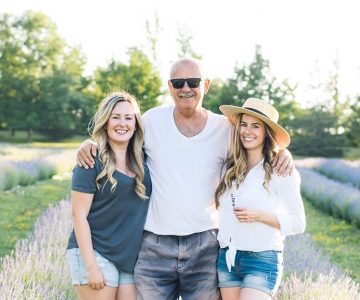
Sister Act: Purple Hill Lavender Farm
Mar 19, 2019 | | FarmingHow Emma Greasley and Jessica Ridding transformed the Creemore farm where they grew up into a lavender dream.
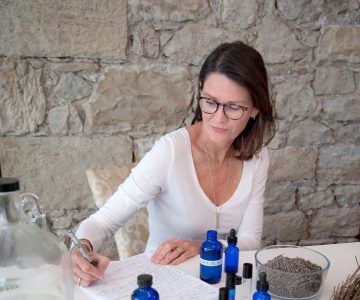
The Doer: Stonewell Farm
Mar 19, 2019 | | FarmingAt Lee Anne Downey’s new lavender farm in Erin, small-batch products and intimate retreats are in the works.
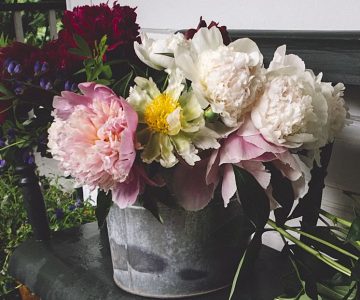
The Peony Pro: Caledon Hills Peony Farm
Mar 19, 2019 | | FarmingLooking for a rare peony variety? Diana Hillman’s got you covered with rootstock from North America and the Netherlands.











